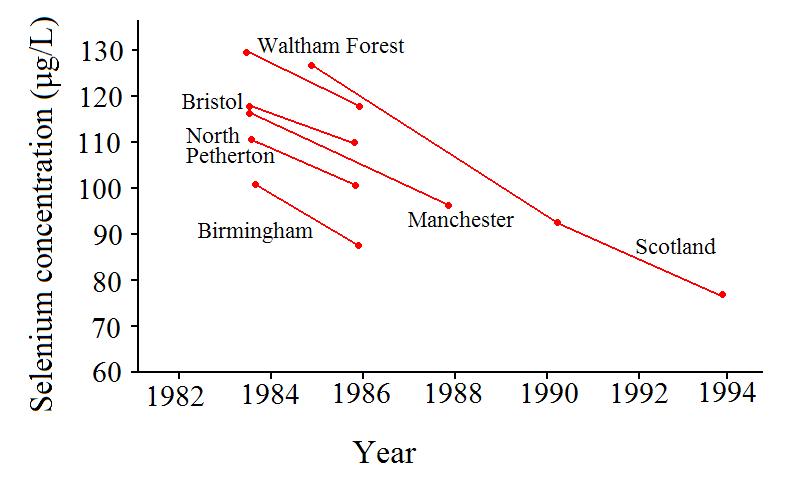![]() elenium is an essential mineral in human nutrition. Dietary selenium is required because the selenium ion is utilised in the structure of number of selenoproteins. Of the selenoproteins, the most widely known is glutathione peroxidise, an enzyme that catalyses the conversion of oxidised to reduced glutathione as part of cellular antioxidant defences. Low levels of glutathione are associated with increased mortality, and high levels are associated with good health. Selenium deficiency is rare, but increasingly, plasma levels at the low end of the normal range are being associated with a number of sub-clinical disorders that are difficult to diagnose and take decades to manifest as disease. Such chromic insufficiency is believed to result in certain types of cancer. Indeed, the seminal paper by Clark in 1996 (here) showed that supplementation with 200 µg selenium reduced the rate of cancer mortality and morbidity by 50 %.
elenium is an essential mineral in human nutrition. Dietary selenium is required because the selenium ion is utilised in the structure of number of selenoproteins. Of the selenoproteins, the most widely known is glutathione peroxidise, an enzyme that catalyses the conversion of oxidised to reduced glutathione as part of cellular antioxidant defences. Low levels of glutathione are associated with increased mortality, and high levels are associated with good health. Selenium deficiency is rare, but increasingly, plasma levels at the low end of the normal range are being associated with a number of sub-clinical disorders that are difficult to diagnose and take decades to manifest as disease. Such chromic insufficiency is believed to result in certain types of cancer. Indeed, the seminal paper by Clark in 1996 (here) showed that supplementation with 200 µg selenium reduced the rate of cancer mortality and morbidity by 50 %.
Traditionally, selenium plasma levels were maintained by consumption of cereal grains. Plants incorporate selenium into their structures during growth and harvest of the cereal grain provided selenium to the diet. However, extensive farming has depleted the soil of selenium and as a result most cereal crops are now a poor source of selenium. Processing of the grain removes most of the remaining selenium content. Dietary selenium is now ingested mainly from animal tissue, as selenium is given to animals in their feed. This is incorporated into the selenoproteins of the livestock, and is them subsequently consumed by humans. However, intakes of selenium are declining rapidly and this decline coincides with the rise in the cases of cancer in Western nations. The rapid decline in the plasma levels of selenium have been reported in a number of studies in the United Kingdom (figure 1).
 Figure 1. Whole blood selenium levels in some United Kingdom areas1. Whole blood concentrations are usually around 20 % higher than plasma levels.
Figure 1. Whole blood selenium levels in some United Kingdom areas1. Whole blood concentrations are usually around 20 % higher than plasma levels.
Mean intakes of selenium have been calculated at around 79 µg/L, which falls to the low end of the acceptable range which is set at 50-197µg/L. The mean value is also below the optimum plasma concentration that is believe to be somewhere around 100 µg/L. That chronic low levels of selenium intakes and depressed plasma levels are deleterious to the immune system is well reported. For example it is known that normally harmless viruses can become virulent when present in a host with low selenium status. Areas of China such as the Henan Province have low selenium soil levels and high rates of certain types of cancer. Because food is deficient of selenium, it is now recommended that selenium supplements are used to boost plasma levels. Most studies have used the highly absorbable organic yeast from of selenium at around 200 µg per day.
RdB
